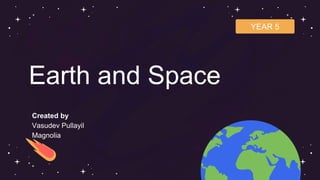
Earth and Space year 5 project Earth, Planets, Space and Sun
- 1. Earth and Space Created by Vasudev Pullayil Magnolia YEAR 5
- 2. Table of contents References Gas planets: Jupiter, Saturn, Uranus, and Neptune Earth Earth’s Layers The existance of life on earth The Solar System Our home: Planet Earth The Moon Rocky Planets: Mercury, Venus and Mars This is the brightest star: The Sun
- 3. Earth: the “Blue Planet” The planet Earth is our home. It has the right atmosphere and to be able to support the life. The earth is the third palnet from the Sun. Why is Earth called the “Blue Planet”? Over 71%of the Earth is covered with water. Therefore from outer space it appears Blue. The Pacific Ocean alone covers half of the globe. Earth is the fifth largest planet in terms of size.
- 4. Earth’s layers The structure of earth is divided into four major components. They are: ● The crust ● The Mantle ● The outer core ● The inner core Each layer has a unique chemical composition, physical state and can impact life on Earth’s surface.
- 5. The existence of life on Earth There are many factors which makes Earth suitable for life are discussed below • Distance from the Sun • Earth’s Atmosphere • Water • Ozone Layer • Climatic condition • Earth’s gravity
- 7. Our Solar system The Solar System is the collection of eight planets and their moon in orbit round the Sun, together with smaller bodies in the form of asteroids, metreoids and comets. a set made up of the Sun and the eight planets that revolve around it. The planets of the solar system are Mercurry, Venus, Earth, Mars, Jupitor, Saturn, Uranus and Neptune.
- 9. This is the brightest star: The Sun The Sun is the star at the center of the solar systeSm. It is a massive hot ball of plasma, inflated and heated by energy produced by nuclear fusion reactions at its core. The Sun is an immense star that emits light and heat. It is the closest star to the Earth and on which all life on Earth depends
- 10. Our home, planet Earth, is a rocky, terrestrial planet. It has a solid, active surface, with mountains, valleys, canyons, plains and much more. Earth is special because it is an ocean planet, with water covering 70% of its surface. Our atmosphere is largely composed of nitrogen. It is made up of three layers: crust, mantle and core. Its natural satellite is the Moon Our home: Planet Earth
- 11. The Moon is Earth’s only natural satellite. The Moon is a rocky celestial body without rings. It does not give off light, but reflects the light it receives from the Sun. The Moon takes different positions, so it does not always present the same illumination. In its path, the Moon goes through four main phases, which are, in order: new moon, first quarter, full moon and last quarter The Moon
- 12. Rocky planets: Mercury, Venus and Mars Mercury It is the closest to the Sun and also the smallest. It is a planet without satellites in its orbit. Its surface, covered with rock and craters, resembles that of the Moon Venus It is the one that most resembles the Earth. It is covered with very thick clouds that reflect sunlight, so that at night it looks bright and we can distinguish it with the naked eye Mars Mars is often called the 'Red Planet', logically because of its reddish appearance. It has the largest volcano of the eight planets in the solar system. One of the great scientific discoveries of recent years has been the finding of subway water on Mars. It has two satellites called Phobos and Deimos
- 13. Gas planets: Jupiter, Saturn, Uranus, and Neptune Jupiter It is a gigantic planet in the solar system: its size is 1,300 times larger than the Earth. It has many natural satellites, the most important of which are Io, Europa, Ganymede and Callisto Saturn Saturn is a yellowish planet and, next to Jupiter, the hottest planet. The most special thing about Saturn is its famous rings composed of rocks and water ice. Some of its natural satellites are Hyperion and Iapetus
- 14. Gas planets: Jupiter, Saturn, Uranus, and Neptune Uranus Uranus is characterized by being a very cold planet because it is far from the Sun. Its axis of rotation is very tilted, and it looks bluish in color because of the gases that form its surface. Uranus also has a ring system and a few natural satellites including Titania, Oberon and Miranda Neptune It is the farthest from the Sun and this makes it the coldest planet in the Solar System. Also, because of the gas in its atmosphere, it appears blue. It has a system of four rings formed by dust particles
- 15. 1 Light takes 8 minutes and 17 seconds to travel from the Sun to the Earth's surface 2 The average distance between the Sun and the Earth is about 150,000,000 km 3 Twelve people have walked on the surface of the Moon, beginning with Neil Armstrong and ending with Gene Cernan. All lunar landings took place between July 1969 and December 1972 as part of the Apollo program 4 Astronauts aboard the International Space Station circle the Earth every 90 minutes, and experience a sunrise and sunset 16 times in each 24-hour period 5 The size of the Earth is 81 times larger than that of the Moon
- 16. References ● Wikipedia ● www.galactic-hunter.com/ ● education.nationalgeographic.org ● www.jagranjosh.com/general-knowledge ● 500 question and answer The Earth
- 17. Thank You